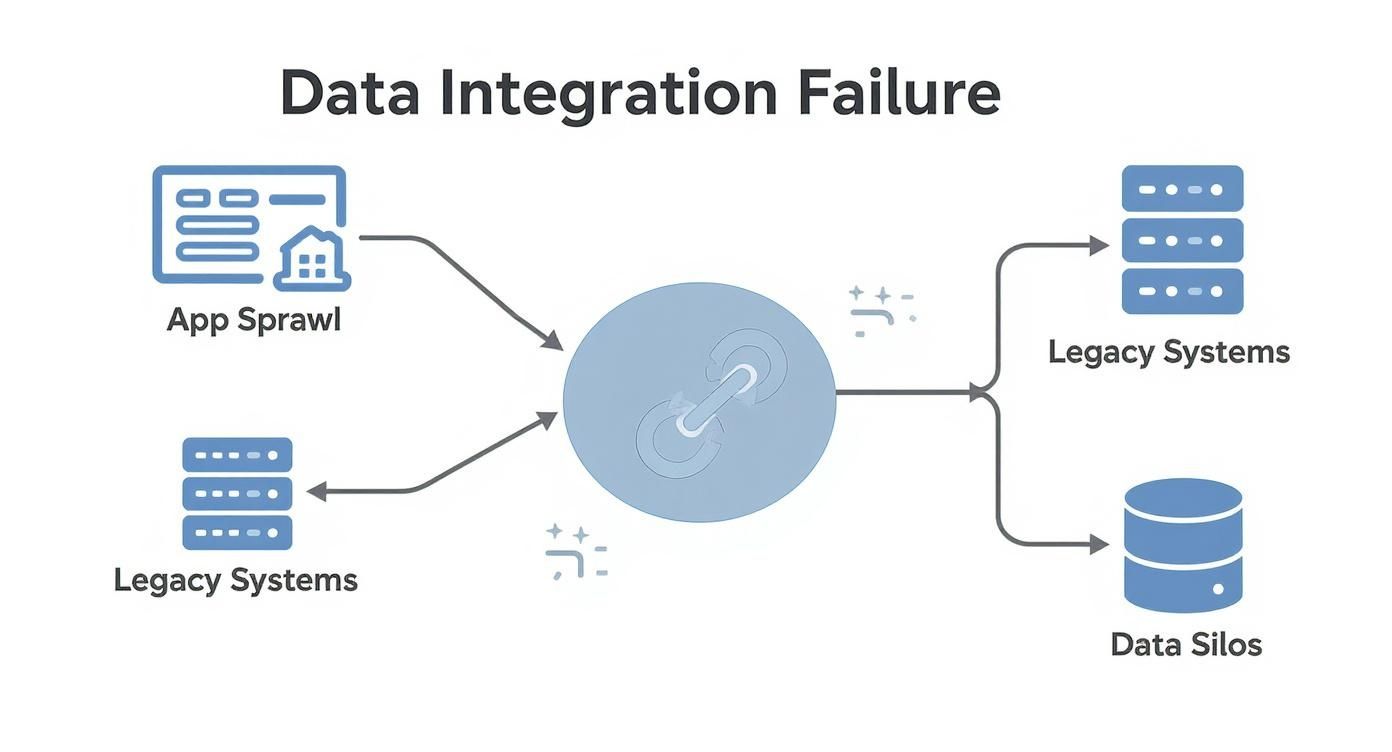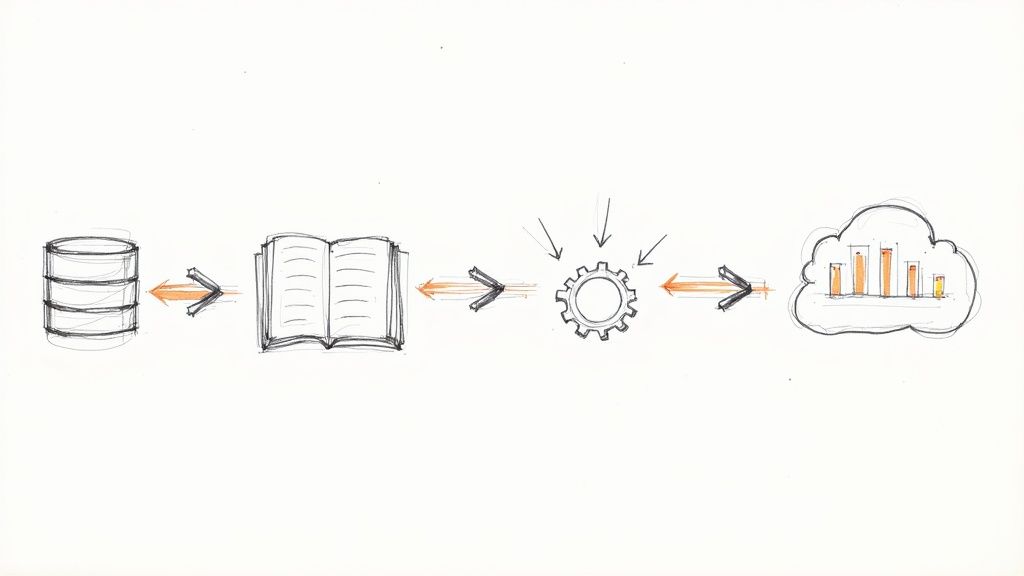Cracking the challenges of data integration
Discover strategies to navigate the challenges of data integration and unlock cleaner, smarter data flows.
At the heart of most data integration headaches are the usual suspects: systems that don't talk to each other, data in a dozen different formats, and the sheer tidal wave of information modern businesses collect. This fragmentation isn't just an IT problem; it's a major business risk that makes simple tasks incredibly complex and sound decision-making almost impossible. It’s a direct roadblock to growth.
Why Disconnected Data Is Costing You More Than You Think
Imagine you're trying to find your way through a new city using five different maps. Each map was made in a different year, with conflicting street names and landmarks. One shows a bridge that was torn down ages ago, while another is missing an entire new highway. You'd be stuck, unable to trust any of your information enough to pick a route.
That's precisely what's happening inside a business running on disconnected data.

Every department—sales, marketing, finance, support—is essentially using its own "map," also known as a data silo. When these systems can't communicate, the fallout is significant. It leads to flawed business intelligence, frustrated customers, and revenue left on the table. The market's quick pivot to data-first operations only makes this problem more urgent.
The Real-World Impact of Data Silos
Disconnected data introduces very real friction that grinds your entire organization to a halt. The day-to-day impact shows up in a few key places:
- Flawed Analytics and Reporting: When marketing and sales data don’t line up, you can't get a straight answer on something as basic as customer acquisition cost or marketing ROI.
- Poor Customer Experience: A support agent has no idea a customer just made a big purchase, so they provide generic, unhelpful advice instead of a personalized solution.
- Operational Inefficiency: Teams waste countless hours on manual data entry and trying to reconcile numbers between departments, opening the door for human error.
This growing need for a single, unified view is why the data integration market is set to grow at a CAGR of 13.8% through 2025, pushed by cloud adoption and the demand for real-time analytics. This trend makes one thing clear: solving data integration challenges isn't just a "nice-to-have" anymore; it's a strategic necessity. For a closer look at how critical this is in other sectors, exploring the specifics of data integration in healthcare shows how seamless systems can directly affect patient outcomes.
The greatest cost of disconnected data isn't just the technology; it's the cost of indecision, missed opportunities, and the organizational chaos it creates. A unified data strategy turns isolated information into a powerful, shared asset.
Understanding Why Data Integration Fails
To really fix data integration, you have to look past the surface-level glitches and understand the deep-rooted issues that cause projects to stall or even fail outright. It’s rarely about a single broken connection. It’s usually a combination of foundational problems creating a domino effect that leaves you with unreliable data and stubborn silos.
Two of the biggest culprits are modern application sprawl and deeply entrenched legacy systems. These aren't just IT buzzwords; they represent real-world business headaches that make a unified data environment feel like an impossible goal.
The Problem of Application Sprawl
Today's companies run on a massive, ever-growing collection of specialized SaaS tools for everything from marketing automation to financial reporting. Each tool is great at its job, but getting them to talk to each other creates a complex and fragile web of connections that is a nightmare to manage.
This isn't a small problem. MuleSoft's 2025 Connectivity Benchmark Report found that the average organization now runs 897 different applications. An astounding 95% of them said they struggle to integrate data across these disparate systems. Every new app adds another layer of complexity, demanding custom integration work and constant maintenance that eats up time and money.
Think of application sprawl like a city where every building has a different type of electrical outlet. To plug anything in, you need a specific, custom-built adapter. The more devices you add, the more tangled and unmanageable that web of adapters becomes.
This uncontrolled growth is a huge driver behind today's data integration challenges, making it nearly impossible to maintain a single source of truth. You can dive deeper into these specific data integration issues in our detailed guide.
The Drag of Legacy Systems
While new applications add complexity, old ones create inertia. Many companies still rely on legacy systems—outdated but mission-critical technologies that hold essential business data. These systems were built before modern APIs were the norm, making them notoriously difficult to connect with newer, cloud-based tools.
They act like anchors, weighing the business down and preventing it from becoming more agile. Getting data out of them is often a slow, manual chore, which is the exact opposite of what you need for real-time analytics and quick decision-making.
These foundational blockers aren't just technical headaches; they are major barriers to building a strong, effective data strategy. Grasping how both application sprawl and legacy systems contribute to failure is the first step toward overcoming them.
Common Data Integration Blockers and Their Business Impact
Let's break down how these technical challenges translate into real business problems. The table below outlines some of the most common blockers, their root causes, and the direct impact they have on operations and strategy.
Integration ChallengeTechnical Root CauseBusiness ImpactData SilosDisconnected applications (SaaS & legacy) with no central access point.Incomplete customer views, inconsistent reporting, and poor decision-making.Schema DriftUnannounced changes in source data structures or formats.Broken data pipelines, data loss, and unreliable analytics dashboards.High LatencyBatch-based data extraction from legacy systems or inefficient pipelines.Delayed insights, missed opportunities, and inability to react to market changes in real time.Poor Data QualityInconsistent data formats, duplicates, and human error across systems.Lack of trust in data, flawed business intelligence, and wasted resources on data cleaning.Lack of GovernanceNo clear ownership or rules for data access, usage, and security.Compliance risks (GDPR, CCPA), data breaches, and uncontrolled data chaos.
Understanding this link between a technical issue like "schema drift" and its business consequence of "broken dashboards" is crucial. It helps everyone, from engineers to executives, appreciate why investing in a solid data integration strategy is so important for the entire organization.
The 5 Core Challenges of Data Integration
While big-picture problems like application sprawl and aging legacy systems create the perfect storm for failure, the real friction happens in the trenches. It’s the day-to-day operational headaches that data teams wrestle with. Getting a handle on these is the first real step toward building a data strategy that actually works—one that transforms scattered information into a powerful, unified asset.
This map breaks down how common blockers like data silos, outdated systems, and sprawling apps can cascade into critical failures.

As you can see, the foundational issues create a domino effect, leaving you with unreliable data and a business that can't get its act together.
1. Data Silos: The Isolated Islands of Insight
Think of your business as an archipelago. Each department—sales, marketing, finance—is its own island, rich with valuable resources (data). But with no bridges connecting them, those resources are stuck. That’s the reality of data silos. Information gets trapped inside individual apps and teams, making it impossible to see the whole picture.
Your sales team might have a goldmine of customer purchase history in their CRM, while the support team holds crucial feedback in their ticketing system. If those two systems can't talk, both teams are flying blind. You end up missing huge opportunities and delivering a clunky, disjointed customer experience.
2. Poor Data Quality: The Foundation of Mistrust
Okay, so you’ve built the bridges between your data islands. But what if the "treasure" you’re moving is just junk? All that integration work is pointless if the underlying information is unreliable. Poor data quality is one of the most stubborn challenges out there, and it absolutely tanks trust in your systems.
This problem shows up in a few familiar, frustrating ways:
- Duplicate Records: You see multiple entries for the same customer, completely skewing your analytics.
- Inconsistent Formatting: One system uses "MM-DD-YYYY" while another uses "DD/MM/YY." Chaos ensues.
- Missing Information: Key fields are left blank, making any kind of deep analysis impossible.
When teams know the data is dirty, they stop trusting it. They fall back on manual spreadsheets and gut feelings, which completely defeats the purpose of becoming a data-driven organization.
3. Real-Time Data Demands: The Need for Speed
It wasn't that long ago that a nightly data sync was good enough. Not anymore. Business operates in real-time, and data has to keep up. The pressure for immediate, up-to-the-second information—what we call low data latency—has become a massive integration roadblock.
Just think about an e-commerce store. If your inventory data only refreshes every hour, you could easily sell an item that just went out of stock. That's a terrible customer experience and a logistical nightmare for your operations team. The same goes for fraud detection, where a delay of just a few seconds can cost a fortune.
Modern business doesn't wait for batch processing. The expectation is for data to be fresh, consistent, and available the moment it's needed. Any delay between an event happening and the data reflecting it is a competitive disadvantage.
4. Evolving Data Schemas: The Shifting Blueprint
Your data sources are living things; they’re constantly changing. The blueprint that defines how data is structured is called a schema. When that blueprint changes unexpectedly—a phenomenon known as schema drift—it can shatter your entire data pipeline. It might be as simple as an engineer adding a new field to an app, renaming a column, or changing a data type.
These small tweaks can cause automated workflows to grind to a halt, leading to lost data or corrupted reports. Trying to manually monitor and fix these breaks is a draining, unsustainable game of whack-a-mole, especially as your number of data sources explodes.
5. Security and Governance: The Rules of the Road
Finally, pulling all your data into one place creates some serious security and governance headaches. Without a solid framework for who can see what, you’re running the risk of exposing sensitive information and violating regulations like GDPR or CCPA.
You have to answer some tough questions:
- Who has permission to access specific datasets?
- How is our data encrypted, both when it's stored and when it's moving?
- What are our policies for retaining and deleting data?
Ignoring these governance challenges is a recipe for disaster, potentially leading to massive fines and a damaged reputation. It’s not enough to just connect your data; you have to control it.
Modern Strategies for Seamless Integration
Let's be honest: acknowledging the headaches of data integration isn't enough. To truly fix the problem, we need to move past the old ways of doing things. The tools that worked in a world of slow, predictable data just can't keep up anymore. Today’s fast-paced environment demands a completely new playbook built for speed, flexibility, and real-time insight.
Think about traditional ETL (Extract, Transform, Load). For years, this was the standard: pull data out, wrestle with it in a separate environment, and then finally load it into a destination. It’s a process that's often too slow and clunky for modern analytics. This has given rise to ELT (Extract, Load, Transform), which flips the script. You load raw data first and then use the immense power of your cloud data warehouse to transform it. The result? Data is available for use much, much faster.
Adopting Real-Time Data Movement
The biggest leap forward, however, is the shift away from processing data in slow, chunky batches. We're now in the era of real-time data streaming, and Change Data Capture (CDC) is at the heart of this revolution. Instead of repeatedly asking an entire database "what's new?", CDC cleverly reads the database's own transaction logs. It captures every single change—every new row, update, or deletion—the moment it happens.
This approach is unbelievably efficient. It puts virtually zero strain on your source systems while ensuring your destinations are updated in milliseconds. For any business that relies on up-to-the-second information for things like fraud detection, live inventory management, or dynamic pricing, CDC isn't just a nice-to-have; it's an absolute necessity.
Modern platforms are designed to make this powerful technology accessible. You can see how a tool like Streamkap provides a clean, visual way to manage these once-complex data flows.

This kind of dashboard simplifies everything. You can connect sources to destinations with a few clicks, and all the gnarly engineering complexity is handled for you. It opens the door for more teams to build sophisticated data pipelines without needing a PhD in data engineering.
Unifying the Ecosystem with Modern Platforms
Beyond the underlying technology, the integration world has been transformed by tools built to tame our ever-growing collection of applications.
- iPaaS (Integration Platform as a Service): These are cloud platforms that act like a central switchboard for your data. They offer pre-built connectors and workflows that link all your different SaaS apps and internal systems, saving you from writing endless custom scripts.
- API-Led Connectivity: This is more of a strategic approach. Instead of creating a messy web of one-off connections, you build a network of reusable APIs. Any team can then tap into these APIs to get the data they need, promoting consistency and making the whole system more agile. For example, modern platforms make historically painful tasks like enabling Salesforce integration to sync customer data much more straightforward.
The goal of modern integration isn't just to connect Point A to Point B. It's about creating a fluid, resilient data ecosystem where information flows freely. By moving from brittle, custom-coded pipelines to scalable, real-time strategies, companies can finally turn disconnected data into their most valuable asset.
These forward-thinking strategies are the foundation for building robust data pipeline architectures that can actually grow with your business. Platforms like Streamkap bring together the raw power of CDC with the simplicity of a managed service. They automatically handle tricky issues like schema changes and guarantee data arrives accurately and on time. This frees up your data teams from the constant firefighting of pipeline maintenance, letting them focus on what they do best: delivering real business value.
Why Your People and Processes Are Key to Integration Success
You can buy the most sophisticated data integration platform on the market, but it’ll fall flat if it runs into a wall of organizational resistance. Technology is only half the equation. The other, often trickier, half involves your people and internal processes. Without the right culture, skills, and strategy, that big investment in shiny new tools can quickly turn into a sunk cost.
This is where the real friction in data integration happens. It's not just about hooking up systems; it's about getting teams on the same page, training your people, and building a mindset where data is seen as a shared, strategic asset—not a departmental trophy.
The Widening Data Skills Gap
One of the biggest hurdles to getting integration right is a straightforward lack of trained people. This human element makes a tough technical problem even harder. Globally, the shortage of skilled data scientists and analysts has become a major bottleneck for integration projects. In fact, Gartner reports that nearly 80% of organizations find it difficult to hire and keep talent who are experts in data integration and revenue analytics.
What does that shortage look like in practice? It means longer implementation times, patchy maintenance, and platforms that never get used to their full potential. SuperAGI offers more insights on how the skills gap impacts revenue analytics. This talent gap also creates a risky dependency on just a few key experts, which slows down projects and stops the rest of the company from becoming truly data-literate.
A data integration tool is only as effective as the team that implements and maintains it. Ignoring the human element is like buying a high-performance race car but having no one who knows how to drive it.
To close this gap, companies need to attack the problem from two angles: hiring new talent and developing the people they already have. This means creating clear career paths for data professionals while also offering accessible training to help business users get more comfortable with data.
Fostering a Truly Data-Driven Culture
A successful integration strategy needs more than just technical chops; it demands a cultural shift. That change has to start at the very top with strong executive sponsorship. When leaders champion data initiatives and spell out their business value, it sends a clear message to everyone else that data is a priority.
Without that high-level backing, data projects often get bogged down in departmental turf wars over data ownership and budget. A truly data-driven culture is one where IT and business units working together is the default, not the exception.
To build this kind of culture, you need to focus on a few key actions:
- Establish Clear Governance: Create a simple framework that defines who owns what data, who can access it, and how it should be used. This gets rid of confusion and builds trust in the data itself.
- Align with Business Goals: Tie every single integration project to a specific, measurable business outcome. Are you trying to improve customer retention? Or maybe optimize the supply chain? Make the connection obvious.
- Promote Cross-Functional Teams: Put people from IT, marketing, sales, and operations on the same project teams. This is the fastest way to break down silos and make sure the solutions you build actually solve real-world business problems.
Ultimately, solving the human side of data integration is all about making data accessible, understandable, and valuable to everyone. When your people and processes are in sync, your technology can finally deliver on its promise.
Frequently Asked Questions About Data Integration
You’re not alone in navigating the tricky bits of data integration. Everyone runs into similar questions along the way. Here are some of the most common ones I hear, with straightforward answers to help you sidestep the usual pitfalls.
What Is the Biggest Challenge in Data Integration?
If there's one villain in the data integration story, it's data silos. It’s the most common and, frankly, most damaging challenge you’ll face.
Think of it like this: your marketing team has its customer data in one system, your finance team has payment info in another, and sales lives in a completely different CRM. None of them talk to each other. They're isolated islands of information. This separation makes it impossible to get a single, trustworthy view of the business, and it's the root cause of so many other problems down the line—like inconsistent reports, duplicated effort, and bad decisions made on incomplete information.
Breaking down these silos isn't just a technical problem solved with a new platform. It requires a shift in mindset, getting everyone to agree on data collaboration and transparency across the entire company.
The real problem with data silos isn't just that the data is separate. It's that the context gets lost. A solid integration strategy is all about piecing that context back together so you can turn isolated facts into actual business intelligence.
How Does Change Data Capture Solve Integration Problems?
Change Data Capture (CDC) is a game-changer for two of the biggest integration headaches: latency and the performance drag on your source systems.
Traditional methods, like old-school batch processing, often query and pull entire databases on a schedule. This is incredibly slow, inefficient, and can seriously bog down your production systems. CDC flips that model on its head.
Instead of grabbing everything, CDC simply watches the database logs and streams only the changes—the inserts, updates, and deletes—the moment they happen. This gives you a flow of fresh data in near real-time without hammering your source databases. It’s perfect for anything that needs up-to-the-second accuracy, like fraud detection or live inventory management. To see how this fits into the bigger picture, check out our guide on what is an ETL pipeline.
What Is the First Step in a Data Integration Project?
This is where so many projects go wrong. The first step has nothing to do with technology—it's all about strategy. Before you even think about tools, you must clearly define the business outcome you're aiming for. It's tempting to jump straight into the tech, but you have to resist.
Start by asking the right questions:
- What specific business problem are we trying to solve here?
- Are we building a 360-degree customer view to cut down on churn?
- Is our goal to optimize the supply chain by finally syncing inventory and logistics data?
When you have a crystal-clear, measurable business goal, it becomes the North Star for every decision that follows—from picking the right data sources to knowing what success actually looks like. A sharp focus on business value is also the best way to get stakeholders on board and secure the budget you need.
Ready to put your data integration challenges behind you? Streamkap uses the power of Change Data Capture to move data in real-time, eliminating latency and freeing your engineers from the headache of managing complex pipelines. Find out how we can help you build a more connected, efficient data ecosystem at https://streamkap.com.



